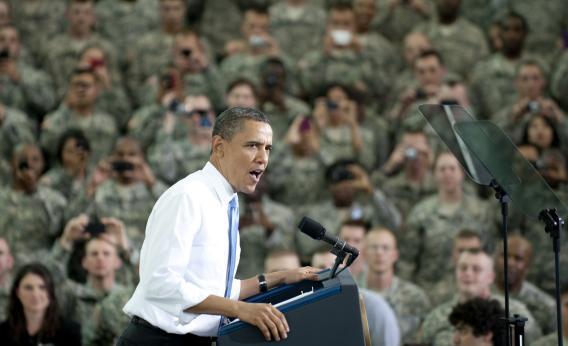Inspired by the New York Times’ expose on Obama’s “secret ‘kill list,’” ProPublica has collected some of the best pieces of watchdog journalism on Obama’s national security policies. For a good introduction, and to see how they’ve evolved since Bush, see their timeline.
A ProPublica national security expert, Dafna Linzer, helped curate this list. If we missed any, please let us know by emailing MuckReads@propublica.org
On Obama’s War on Terror
Getting Bin Laden, The New Yorker, August 2011
Twenty-three Navy SEALs, one Pakistani-American translator and a dog named Cairo: Nicholas Schmidle’s gripping narrative brings to life the night they killed Bin Laden, as well as the hunt that led to the end of the man Obama had dubbed a top national security priority. ProPublica reporter Dafna Linzer also recommended this Time article (paywalled) as a seminal piece on the hunt for Bin Laden.
Secret “Kill List” Proves a Test of Obama’s Principles and Will, New York Times, May 2012
Obama’s hands-on counterterrorism record means that he, in effect, is “personally overseeing the shadow war with Al Qaeda.” But some officials criticize his tactics – like a formula for counting civilian deaths that may significantly lower the actual numbers.
On Drones
Inside the Killing Machine, Newsweek, February 2011
In 2011, at the time of this article’s writing, the American public knew the military used drones to kill suspected terrorists. But the formal process of deciding who should be hunted and killed had never been reported – until Tara Mckelvey snagged an exclusive interview with a man at the CIA who approved these “lethal operations.”
The Rise of the Killer Drones: How America Goes to War in Secret, Rolling Stone, April 2012
In war, soldiers used to have to point a gun at the enemy to kill. Today, they simply have to push a button from a station on their base, what some say is like playing a video games. This piece is one of the most in-depth looks we found on the rise of the U.S. drone program, and how it’s changed the way we fight. For a cheat sheet on everything you ever wanted to know about drones, see our guide.
On Cybersecurity
Cyber-Intruder Sparks Massive Federal Response–And Debate Over Dealing With Threats, Washington Post, December 2011
The military discovered that malware, borne on somebody’s thumb-drive, had infiltrated their classified network in 2008. The resulting investigation set off a battle over the rules of engagement for cyber warfare, finally restricting the military to defending its own networks and not crossing into civilian or other federal agencies’ turf.
On Intelligence
Top Secret America: A Hidden World, Growing Beyond Control, Washington Post, July 2010
Since 9/11, the United States’ intelligence operations have ballooned. An estimated 854,000 people hold top-security clearances, nearly 1.5 times as many people as live in Washington D.C., and comprise part of a network so sprawling that it’s sometimes hard for top officials to keep track of it all.
The NSA Is Building the Country’s Biggest Spy Center (Watch What You Say), Wired, March 2012
The National Security Agency’s under-construction data center in Utah will cost $2 billion and sprawl over 1 million square feet, more than five times the size of the U.S. Capitol. When it’s done, likely in September 2013, it will be “the country’s biggest spy center.” And part of its duties may be to monitor your personal data.
On Prosecuting Leaks
The Secret Sharer, The New Yorker, May 2011
Though Obama trumpeted the value of whistle-blowers when he entered office, he’s also launched an aggressive crackdown on government leaks. The case of Thomas Drake, a former senior executive at the National Security Agency, is a prime example of the tension between whistle-blowers who reveal wrongdoing and leaks that jeopardize national security.
Sealing Loose Lips: Obama’s Crackdown on Leaks, ProPublica, March 2012
Our timeline of leak prosecutions under the Espionage Act – and how they’ve picked up steam under Obama.
On the Middle East and Afghanistan
In Yemen, U.S. Airstrikes Breed Anger, and Sympathy for Al Qaeda, Washington Post, May 2012
The Obama administration has escalated airstrikes in Yemen against high-ranking al Qaida leaders, but is it coming at a cost? This article describes the backlash in Yemen against civilian deaths and what’s seen as an incursion on their sovereignty.
U.S. Not Reporting All Afghan Attacks, Associated Press, April 2012
An Associated Press exclusive found the military doesn’t report nonfatal attacks on coalition troops by Afghan policemen and soldiers, even though the incidents are an important indication of the level of mistrust between Afghan and coalition troops. A military spokesman says this is due to differences in policy between coalition governments on reporting attacks.
Two Top Lawyers Lost To Obama in Libya War Policy Debate, New York Times, June 2011
Obama rejected the views of top Pentagon and Justice Department lawyers when he decided to continue America’s role in the air war in Libya without Congressional authorization: a legal, but “extraordinarily rare” move. According to Dafna, this is one of the most significant national security stories of Obama’s presidency, having “more to do with war power and executive authority than anything else.”
Congratulations, you finished! Now test your knowledge by taking ProPublica’s quiz: Obama vs. Bush on National Security.
